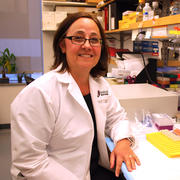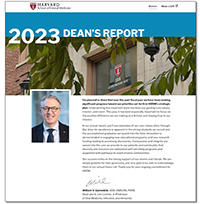
Dr. Francesca Gori, assistant professor of Oral Medicine, Infection and Immunity, has a longstanding interest in studying the cellular and molecular pathways underlying cell fate and differentiation. Her research focuses on the identification and characterization of genes that regulate bone development and homeostasis as potential therapeutic targets. Recently, she was awarded an R56 National Institutes of Health (NIH) Award, as well as the William F. Milton Fund Award from Harvard University’s Office of the Provost to fund two studies that may lead to insights in human diseases associated with bone fragility, healing and regeneration.
“I’m thrilled to receive these awards as they will give me the tools to contribute my share, small though it may be, to the bone field. It has been a marathon, not a sprint, but the bottom line is that I will work on something exciting and that’s what matters to me. I’m grateful to Dr. Baron and others at HSDM who have supported me over the years,” Gori said.
Dr. Gori earned her PhD in biology from the University of Florence, Italy. She came to HSDM after stints at the Mayo Clinic and Massachusetts General Hospital. At the MGH, Gori identified a novel gene, Wdr5 and with an NIH training grant and a R21 grant, she investigated its effect on skeletal development. For this work, she was awarded the Harold Frost Young Investigator Award of the American Society of Bone and Mineral Research (ASBMR) in 2005 and the John Haddad Young Investigator Award of the Advances in Mineral Metabolism (AIMM) in 2007.
Her work in the Baron-Gori Lab has focused on investigating the molecular, cellular and genetic basis of skeletal homeostasis and its regulation in health and disease with emphasis on the mechanisms by which Wnt signaling regulates bone homeostasis. Gori, in collaboration with Dr. Roland Baron, published in three important publications (Nature Medicine in 2014, New England Journal of Medicine in 2016 and PNAS in 2019). It is during this collaboration that she started to lay the groundwork for her current projects.
In Gori’s NIH study, “Biology of Cortical Bone of Long Bones and Calvarium. Role of Sfrp4 in the Local Regulation of Wnt Signaling,” she will explore the biology of the periosteal and endosteal surfaces of the cortex and the way in which they communicate, possibly through the osteocytes. The main objective is to identify the role that Sfrp4-mediated signaling plays in regulating their activity. This will be translatable to human diseases associated with cortical bone fragility and other endocrine or skeletal abnormalities and may lead to development of novel therapies to treat low cortical bone mass-associated disorders. Part of the project will be performed in collaboration with Dr. Matthew Greenblatt at Cornell University.
In the project, “Biology of Cortical Bone: Role of Sfrp4 in the Local Regulation of Periosteal Stem Cells and Osteoprogenitors,” funded by the William F. Milton Fund, Gori proposes using innovative techniques and mouse genetics to identify how Sfrp4-mediated signaling contributes to the expansion, differentiation and/or function of periosteal stem cells/progenitors. With these studies, she hopes to gain a greater understanding of the mechanism underlying cortical biology and therefore human diseases associated with cortical bone fragility, bone healing and regeneration.


